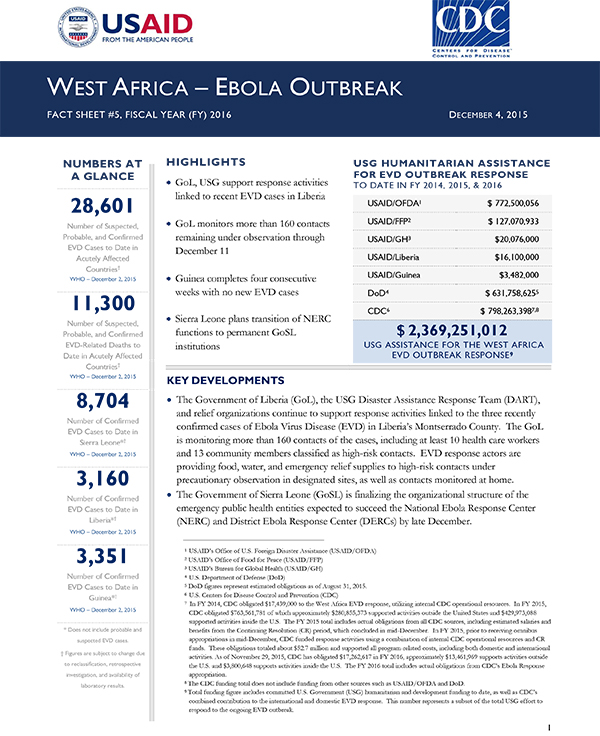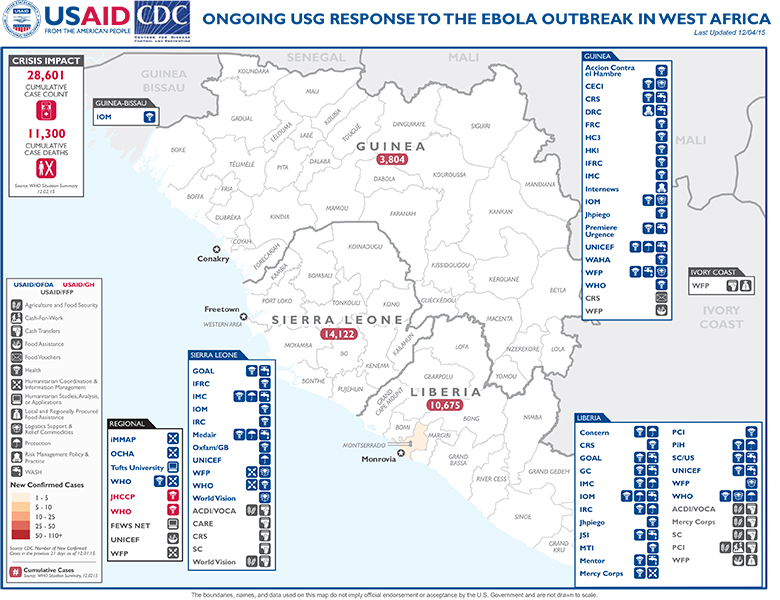Speeches Shim
December 4, 2015
HIGHLIGHTS
Ebola Response
Visit our main West Africa Ebola Outbreak page to learn more about how we're responding to the West Africa Ebola outbreak, and what you can do to help.
- GoL, USG support response activities linked to recent EVD cases in Liberia
- GoL monitors more than 160 contacts remaining under observation through December 11
- Guinea completes four consecutive weeks with no new EVD cases
- Sierra Leone plans transition of NERC functions to permanent GoSL institutions
KEY DEVELOPMENTS
- The Government of Liberia (GoL), the USG Disaster Assistance Response Team (DART), and relief organizations continue to support response activities linked to the three recently confirmed cases of Ebola Virus Disease (EVD) in Liberia’s Montserrado County. The GoL is monitoring more than 160 contacts of the cases, including at least 10 health care workers and 13 community members classified as high-risk contacts. EVD response actors are providing food, water, and emergency relief supplies to high-risk contacts under precautionary observation in designated sites, as well as contacts monitored at home.
- The Government of Sierra Leone (GoSL) is finalizing the organizational structure of the emergency public health entities expected to succeed the National Ebola Response Center (NERC) and District Ebola Response Center (DERCs) by late December.
Liberia
During the week of November 15, the GoL confirmed three new EVD cases—two children and their father—in Montserrado’s Paynesville area near the capital city of Monrovia. The cases were the first recorded as EVD-positive in Liberia since July. On December 3, health care workers at the ELWA 3 EVD treatment unit in Montserrado discharged two of the EVD cases following two consecutive negative tests for EVD; the third case—one of the EVD-positive children—died on November 23 after undergoing treatment at EWLA 3.
EVD response actors—including USAID/OFDA partners Global Communities (GC), International Medical Corps (IMC), the International Rescue Committee (IRC), and the UN Children’s Fund (UNICEF)—continue to support the Montserrado County Health Team to conduct case management and community outreach activities related to the recent cluster of EVD cases. The GoL is monitoring more than 160 contacts of the cluster, who will remain under observation until completion of a 21-day monitoring period on December 11.
Following the new cases, UNICEF-trained social mobilizers increased outreach efforts in Montserrado to promote key EVD-prevention behaviors, such as safe hygiene and sanitation. As of November 30, social mobilizers had distributed more than 200 hand-washing buckets to households in the affected area, while seven radio stations in Montserrado were disseminating EVD awareness and prevention messages, including the need to report community deaths for dead body swabbing.
Response actors, such as USAID/OFDA partners IMC and the MENTOR Initiative, are also assessing infection prevention and control (IPC) standards and providing IPC support to nearly 70 health care facilities in Montserrado. In addition, IRC is providing fuel, personal protective equipment, and hygienists for standby ambulances to enable the safe transport of suspected EVD cases. GC continues to manage 10 safe and dignified burial teams in Montserrado to inter the bodies of deceased individuals from high-risk populations.
West Africa Map - 12-04-2015 ![]() (pdf - 581k)
(pdf - 581k)
Sierra Leone
The GoSL and EVD responders continue to provide health and psychosocial support to EVD survivors across Sierra Leone. As part of sexual health support for EVD survivors, the NERC plans to launch a pilot semen-testing program in the priority districts of Bombali, Port Loko, Western Area Rural, and Western Area Urban in early December. These areas have high concentrations of EVD survivors, with the GoSL registering more than 2,000 survivors across the four districts. Although many survivors contracted EVD more than nine months ago, the pilot program plans to prioritize individuals who began recovering from EVD within the previous nine months—the maximum observed duration for EVD persistence in semen. The NERC has identified and validated collection sites and laboratories for each district, with technical support from CDC and the UN World Health Organization (WHO), and has developed a preliminary survivor-testing framework. Survivor enrollment in the pilot is currently underway; if successful, the GoSL plans to introduce the program in additional districts. Under the existing framework, participants submit samples every 25–35 days, and the program will discharge individuals following two consecutive EVD-negative samples.
The GoSL continues to finalize the emergency public health entities that will succeed the NERC and DERCs after the centers stand down in late December. As the lead ministry on public health issues, the GoSL Ministry of Health and Sanitation plans to manage the Public Health National Emergency Operations Center (PHNEOC)—formerly the NERC Emergency Operations Center. A Public Health Emergency Management Committee (PHEMC)—comprising representatives from donors, partners, and relevant GoSL ministries—is intended to provide strategic direction to the PHNEOC during the emergency phase of a public health incident. During non-emergency periods, the PHEMC will contribute to the development of a preparedness strategy to address both future infectious disease outbreaks and the public health-related effects of natural disasters.
Guinea
On November 20, the Government of Guinea convened key partners—including USAID/OFDA and CDC—to discuss strengthening Guinea’s disease surveillance system. In accordance with the WHO Phase 3 strategy for the EVD response in West Africa, the meeting emphasized the importance of community-based surveillance as part of broader efforts to strengthen infectious disease alert systems. USAID/OFDA partners continue to support EVD surveillance in high-risk areas of Guinea; for example, the International Organization for Migration (IOM) is promoting community event-based surveillance in an estimated 250 communities bordering Guinea-Bissau and Sierra Leone.
From November 18–21, more than 80 response actors participated in a national workshop outlining case management plans for infectious diseases, especially EVD. The workshop also addressed strategies for maintaining IPC measures in health facilities and evaluated current needs, such as training for health care workers, establishment of triage structures at key health facilities, and continued protocol assessments.
In accordance with the national case management strategy, USAID/OFDA continues to support IPC training in health facilities throughout Guinea. USAID/OFDA partner Jhpiego, for example, has trained more than 5,000 health care workers on IPC protocols in the capital city of Conakry and Boké, Faranah, Kindia, and Nzérékoré prefectures. In addition, the DART is emphasizing the need to bolster post-training monitoring and supervision at health facilities to ensure continued adherence to IPC procedures.
PUBLIC DONATION INFORMATION
- The most effective way people can assist relief efforts is by making cash contributions to humanitarian organizations that are conducting relief operations. A list of humanitarian organizations that are accepting cash donations for disaster responses around the world can be found at www.interaction.org.
- USAID encourages cash donations because they allow aid professionals to procure the exact items needed (often in the affected region); reduce the burden on scarce resources (such as transportation routes, staff time, and warehouse space); can be transferred very quickly and without transportation costs; support the economy of the disaster-stricken region; and ensure culturally, dietary, and environmentally appropriate assistance.
More information can be found at:
- The Center for International Disaster Information: www.cidi.org or +1.202.821.1999.
- Information on relief activities of the humanitarian community can be found at www.reliefweb.int.
USAID/OFDA bulletins appear on the USAID website at what-we-



Comment
Make a general inquiry or suggest an improvement.